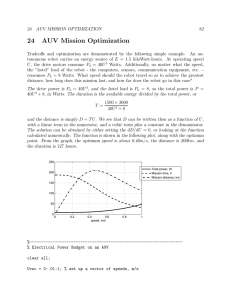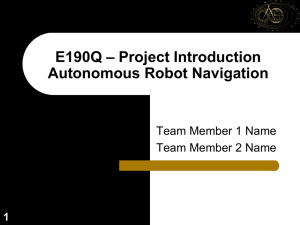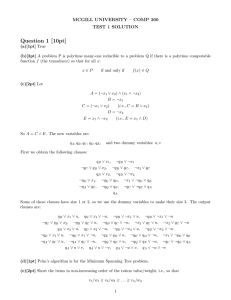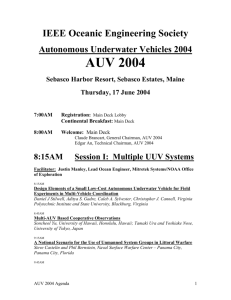Energy Priority and Current Model Based AUV Cruise Path Planning
advertisement
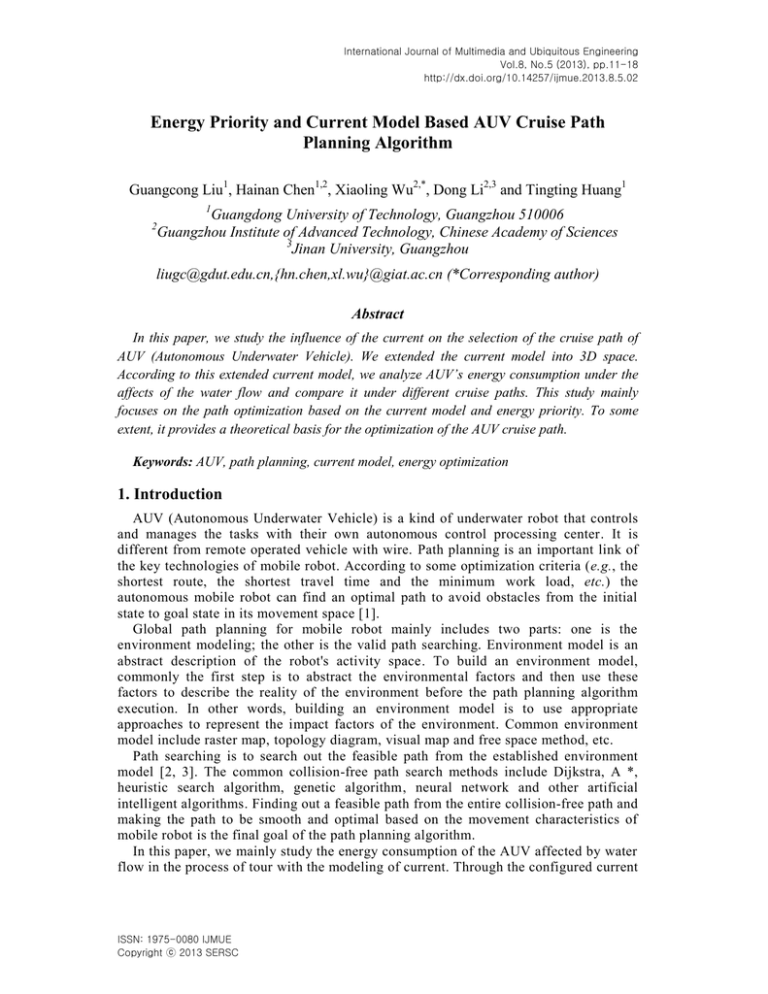
International Journal of Multimedia and Ubiquitous Engineering
Vol.8, No.5 (2013), pp.11-18
http://dx.doi.org/10.14257/ijmue.2013.8.5.02
Energy Priority and Current Model Based AUV Cruise Path
Planning Algorithm
Guangcong Liu1, Hainan Chen1,2, Xiaoling Wu2,*, Dong Li2,3 and Tingting Huang1
1
2
Guangdong University of Technology, Guangzhou 510006
Guangzhou Institute of Advanced Technology, Chinese Academy of Sciences
3
Jinan University, Guangzhou
liugc@gdut.edu.cn,{hn.chen,xl.wu}@giat.ac.cn (*Corresponding author)
Abstract
In this paper, we study the influence of the current on the selection of the cruise path of
AUV (Autonomous Underwater Vehicle). We extended the current model into 3D space.
According to this extended current model, we analyze AUV’s energy consumption under the
affects of the water flow and compare it under different cruise paths. This study mainly
focuses on the path optimization based on the current model and energy priority. To some
extent, it provides a theoretical basis for the optimization of the AUV cruise path.
Keywords: AUV, path planning, current model, energy optimization
1. Introduction
AUV (Autonomous Underwater Vehicle) is a kind of underwater robot that controls
and manages the tasks with their own autonomous control processing center. It is
different from remote operated vehicle with wire. Path planning is an important link of
the key technologies of mobile robot. According to some optimization criteria (e.g., the
shortest route, the shortest travel time and the minimum work load, etc.) the
autonomous mobile robot can find an optimal path to avoid obstacles from the initial
state to goal state in its movement space [1].
Global path planning for mobile robot mainly includes two parts: one is the
environment modeling; the other is the valid path searching. Environment model is an
abstract description of the robot's activity space. To build an environment model,
commonly the first step is to abstract the environmental factors and then use these
factors to describe the reality of the environment before the path planning algorithm
execution. In other words, building an environment model is to use appropriate
approaches to represent the impact factors of the environment. Common environment
model include raster map, topology diagram, visual map and free space method, etc.
Path searching is to search out the feasible path from the established environment
model [2, 3]. The common collision-free path search methods include Dijkstra, A *,
heuristic search algorithm, genetic algorithm, neural network and other artificial
intelligent algorithms. Finding out a feasible path from the entire collision-free path and
making the path to be smooth and optimal based on the movement characteristics of
mobile robot is the final goal of the path planning algorithm.
In this paper, we mainly study the energy consumption of the AUV affected by water
flow in the process of tour with the modeling of current. Through the configured current
ISSN: 1975-0080 IJMUE
Copyright ⓒ 2013 SERSC
International Journal of Multimedia and Ubiquitous Engineering
Vol.8, No.5 (2013)
model, randomly selecting three different travel paths to reach the same destination,
comparing the energy decrease of three tour routes, and then to examine the flow's
influence on the path of AUV cruises. With these influence, we would finally get the
best path between the begin point and the destination. This article does not consider
complex obstacle underwater environment, the purpose of this article is to provide
theoretical basis for the research, which is using natural underwater conditions to
improve the performance of the AUV, for route choice of more complex obstacle
underwater is not the focus of this article.
2. State of Arts
In the past, AUV was mainly used in deep submergence assignments, such as
submarine topography exploration, submarine cable accident repair, etc. In addition,
due to its inherent ability to adjust its own position quickly and its good underwater
maneuvering performance, AUV has been widely used in the underwater sensor
network. AUV utilizes its maneuvering characteristics to avoid network deployment
hole, or participates in the relay to enhance signal transmission and data collection.
AUV can greatly improve the application ability of underwater sensor networks .
According to different emphasis of path planning, the researchers have carried out
related researches. Guldner J. et al., [4] proposed a three-layer control structure is
suitable for clutter environment robot path planning. In his research the first layer is the
global path planning. The second layer is the local path planning of artificial potential
field. And the last is the course Angle method. Dieguez A. R. [5] also presented a
combination method of six levels, including global planning and local planning, sensor
information fusion, path selection, intelligent supervision and navigation, this method
can get a better path, and has the characteristic of real-time local planning. With the
rapid development of science and technology, some intelligent techniques are applied to
mobile robot path planning, such as neural network, genetic algorithm and fuzzy control
[6], etc. Lee M. C. and Park M. G. [7] solved the problem of local minimum of artificial
potential field with combined artificial potential field method and simulated annealing
algorithm. Mbede J. B. [8] designed the fuzzy controller with combined fuzzy logic and
artificial potential field function and this controller can solve the problem of real-time
path planning with dynamic unknown obstacles. With their effort, the efficiency of path
planning has significantly improved.
The current research of the AUV’s path planning is mainly focused on the real-time
job environment. With this in mind, the most important factor in the AUV ’s path
planning is that AUV must finish its mission as soon as possible. Since the AUV is
more and more valuable in the underwater sensor network applications, we gradually
discovered that the cruising ability is another point. In the UWSN (Underwater
Wireless Sensor Networks) application, the AUV should continuously cruise under the
water to maintain the network topology. So in the study of the AUV ’s path planning,
the minimization of energy consumption is also very important. This paper just focuses
on this issue and studies the current’s effect on AUV’s energy consumption.
3. Path Optimization Based on the Current Model
The AUV must have enough energy to improve its cruise ability. On one hand, we
can study the efficient energy storage technology to extend the AUV ’s cruise time.
Some researchers presented the energy harvesting technology to harvest the
12
Copyright ⓒ 2013 SERSC
International Journal of Multimedia and Ubiquitous Engineering
Vol.8, No.5 (2013)
environment energy for AUV’s cruise [9] which also improved the cruise time of the
AUV. On the other hand, we can analyze the AUV’s cruise process to find out the
optimal job scheme and reduce the energy consumption. The goal of this paper is to
optimize the cruise project and reduce the energy consumption through the analysis of
the AUV’s task processing during the AUV’s cruise course, and finally to improve the
cruise ability.
Since the active environment of the AUV is underwater, so the main resistance
during the cruise is coming from the current. If we reduce the current resistance as
much as we can, or even to make use of the water flow to drive the AUV, this would
make great promotion to the AUV’s endurance ability.
3.1. Current Model
For the current model, there has been some valuable research in the early stage of the
Physical Oceanography and the Pure Kinematics. In these studies, velocity field was
used to describe the water flow. According to the scholar’s research, they found the
oceans are a stratified rotating fluid, hence vertical movements are, almost everywhere,
negligible with respect to the horizontal ones [10]. And the vertical movements of the
float are usually limited to damped oscillations around the reference density surface
triggered by internal waves [11]. With this study, Bower [12] used the current model to
explain the properties of the observed paths of isopycnal floats released in the Gulf
Stream. In paper [13] processed the key issues in the field of hydrology and water
resources, the state-of-the art, the major progress and problems in studies and
applications of distributed hydrological models.
This paper mainly studies the influence of the current on the selection of the AUV’s
cruise path. Since the cruise path of the AUV is always in the three -dimensional space,
we must build a current model in three-dimensional space to plan the AUV’s cruise
path, and then we can get a real simulative environment. Up to now, the recent
researches mainly analyze the current model in the two-dimensional space with plane
analysis. To address this problem, we adopt the random offset vector to set the offset of
the vertical direction based on the existing current model. With this offset vector we
can simulate the current in the 3D space.
Figure 1 demonstrates a simulation water flow in the 3D space by the random offset
vector and the stratified feature based on the existing current model. To study the
energy consumption, we set three different paths for the AUV to reach the same
destination. The point A is the current position of the AUV, and B is the destination.
Among the three paths, the AB is the direct route. In the ACB route, AUV first go to C
point and then goes to the destination B. In the ADB route, it first goes to D, and then
goes to B point.
Copyright ⓒ 2013 SERSC
13
International Journal of Multimedia and Ubiquitous Engineering
Vol.8, No.5 (2013)
B
9
C
8
Z Direction
7
6
5
4
D
A
3
5
0
2
Y Direction
-5
1
0
2
4
-10
6
8
10
12
14
16
18
20
X Direction
Figure 1. The current graded model and cruise path in 3D space
3.2. The Effect of the Current on Energy Consumption
The effect of the current is the most important factor to optimize the cruise path.
When AUV is in the reverse flow, it must overcome the resistance of the current.
Compared with the down-flow, it would consume more energy to go forward. So
without considering the barrier and time priority, we should include the down -flow area
in the path as much as possible, and use the current’s flow to reduce the AUV’s energy
consumption, furthermore it can shorten the AUV’s cruise time.
To make it clear, we suppose the AUV get the present current model and accurately
get its logical position and the destination position. Once the cruise area model is
established, the problem of the cruise path optimization would be converted to the
problem of minimizing the angle between the tangent vector of the cruise path and the
velocity field’s tangent vector. When this angle is too large, then the water flow does
negative work to AUV. At this stage the energy consumption is obvious. On the
contrary, if this angle is small, water flow can do positive work. Water flow drives the
AUV go ahead, so this can reduce the energy consumption. When AUV is in the ocean
environment, it can even use the ocean current and vortex to cruise without power,
which would effectively improve the AUV’s cruise ability.
For the convenience of discussion, we make the following definitions:
y B(t )sin(k ( x ct ))
f ( x, y, t ) tanh
2 2
2
1 k B (t ) cos (k ( x ct ))
dx
f ( x, y, t )
x
dy
f ( x, y, t )
y
(1)
(2)
The f ( x, y, t ) represents the observation spot’s relative position in the plane with the
time factor. In this function B(t ) A cos( t ) modulates the width of the meanders.
And the parameter k sets the number of meanders in the unit length; c is the phase
14
Copyright ⓒ 2013 SERSC
International Journal of Multimedia and Ubiquitous Engineering
Vol.8, No.5 (2013)
speed with which they shift downstream; A determines the average meander width, is
the amplitude of the modulation, and is its frequency. In this paper, we will use A =
1.2, c = 0.12, k = 2 /7.5, = 0.4, = 0.3. To simplify the current model we set t = 0
and set the following offset to represent the current in the plane:
f yi f ( x, y,0) | y E i
(3)
The E is the maximum y position value of test area and is the offset factor; i is
the times of the offset. According to the expression (1), (2) and (3), we can get any
point’s derivative of the x-axis direction in the test area as follows:
F'
dx
dy
(4)
The expression (4) also represents the current’s instantaneous velocity direction.
Next the pA represents the AUV’s current position and pB is the destination. The vector
p presents the AUV’s instantaneous cruise direction. The q represents the current
position’s direction of water flow.
p pB pA
q (1, F ' ) (5)
p, q
(6)
We can use to measure the current’s effect to the AUV’s cruise.
3.3. Get the Optimal path
Through the above discussion, it is clear that if the γis bigger the resistance would
be stronger. So to find out the optimal path, we should let the accumulated value of γ
to be minimum. However, we’ve assumed that the AUV’s move trend should be the
destination’s direction. To achieve the above discussions balance, we propose the
following algorithm.
In this algorithm, we just focus on the current’s resistance and energy efficiency. So
we set aside the real-time, and we assume that during the selected path there will no
barriers.
Algorithm 1
Variable descriptions: βis the angle of the next move direction vector and the current direction
vector; e and g is the weighting factor; 0<e<1, 0<g<1;
1: if γ == 0°
2: β = 0°;
3: endif
4: else
5: if γ> 0°andγ < 90°
6:
β= eγ;
7: endif
8: else
9:
β= gγ;
10: endelse
11: endelse
Copyright ⓒ 2013 SERSC
15
International Journal of Multimedia and Ubiquitous Engineering
Vol.8, No.5 (2013)
According to the Algorithm 1, we can get the βvalue. And then we can get the
AUV’s next direction vector. Every several time intervals, we use this algorithm to
correct the AUV’s course.
3.4. Performance Analysis
As we discussed above, we adopt the MCM (Meandering Current Mobility) model [4]
to study the effect of the current to AUV’s cruise. Firstly we decompose the
instantaneous velocity field to get the current direction vector, and then calculate the
angle between the direction vector and the tangent vector of cruise path to measure the
energy consumption. Finally we evaluate the pros and cons of different cruise path s by
energy consumption. During the simulation, as the angle is the effect factor of the
current cruise path, we can only consider the current’s effect, which shows that the
effect factor is proportional to energy consumption. The greater the angle, the stronger
the resistance of the current and the more the energy consumption. In the 3D space
underwater environment the vertical movements of the float are usually limited to
damped oscillations around the reference density surface triggered by internal waves .
So in our study, the paths in Figure 1 would be projected onto the horizontal plane.
Figure 2 illustrated this condition. Figure 2 illustrates 5 paths, 3 Break Point Paths, one
Down-flow Path and the Refulgence Path. When in the Break Point Path, the AUV goes
to the destination following the straight line no matter in the down-flow or in the
adverse current. The other two paths were the result of our algorithm respectively
represents the down-flow path and the adverse current path. According to this figure,
we can see that, in our selected path, the AUV would follow the current’s flow trend to
avoid the water flow’s resistance.
4
Break Point Path
Down-flow Path
Refluence Path
2
0
Y Direction
-2
-4
-6
-8
-10
0
2
4
6
8
10
12
14
16
18
20
X Direction
Figure 2. The projected paths
16
Copyright ⓒ 2013 SERSC
International Journal of Multimedia and Ubiquitous Engineering
Vol.8, No.5 (2013)
100
Break Path 1
Break Path 2
95
Break Path 3
Down-flow Path
Rest Energy(%)
90
85
80
75
70
65
0
2
4
6
8
10
12
14
16
18
20
Distance
Figure 3. Energy consumption of different paths when in down-flow
100
Break Path 1
Break Path 2
90
Break Path 3
Down-flow Path
Rest Energy(%)
80
70
60
50
40
0
2
4
6
8
10
12
14
16
18
20
Distance
Figure 4. Energy consumption of different paths when in countercurrent
In our simulation experiment, we adjust the navigation direction according to the
current position’s water flow direction. So in our algorithm we firstly calculate the
water flow direction vector. Then we can get the next step’s direction. Figure 3 and
Figure 4 illustrated the performance of our algorithm.
Figure 3 shows the different path’s energy consumption when the AUV is in the
down-flow. According to this figure, we can see that the path selected by our algorithm
is always consuming less energy than other three Break Point Paths. During the whole
route, the maximum distinction of the energy consumption is almost 8%, and at the end
the Down-flow Path’s rest energy is 2% larger than others.
Copyright ⓒ 2013 SERSC
17
International Journal of Multimedia and Ubiquitous Engineering
Vol.8, No.5 (2013)
Figure 4 illustrats the AUV’s energy consumption when it is in the countercurrent.
From this figure, we can see that the red line which represents the selected path by our
algorithm is above other lines. This means that even in the countercurrent our algorithm
can also select the better path. But on the other hand, we can see that the superiority is
not obvious. All of the five path’s energy consumption trend is almost unanimously.
That is because they are in the countercurrent and the resistance of the water flow
covered the effect of the course adjustment.
The summarized experimental results tells us that we can adjust the AUV’s course to
comply with the water flow’s trend to reduce the energy consumption. That is why our
algorithm doesn’t perform very well in the countercurrent environment. But in the
down-flow it can get good results.
4. Conclusion
This paper investigated the different AUV cruise path’s energy consumption under
the current model. Our numerical and analytical results clearly show that it can reduce
the energy consumption when we plan the AUV’s cruise path. Our simulation results
show that our algorithm is effective. The research of the effect to AUV is important. In
the future we will continuously study the AUV’s path planning based on the current
model to improve the AUV’s cruise ability and performance.
Acknowledgement
This work was supported by Guangzhou Municipal Science and Technology Business
Incubator excellent team project funding (No. 7411655944084).
References
[1] D. K. Qu, Z. J. Du, D. G. Xu and F. Xu, “Research on Path Planning for a Mobile Robot”, ROBOT, vol. 30,
no. 2, (2008), pp. 97-101, 106.
[2] G. Wang, “A Modified Firefly Algorithm for UCAV Path Planning”, International Journal of Hybrid
Information Technology, vol. 5, no. 3, (2012).
[3] H. N. M. Shah, “Develop and Implementation of Autonomous Vision Based Mobile”, International Journal of
Advanced Science and Technology, vol. 51, (2013).
[4] J. Guldner, V. I. Utkin and R. Bauer, “A three‐layered hierarchical path control system for mobile robots:
Algorithm and experiments”, Robotics Autonom System, vol. 14, no. 2‐3, (1995), pp. 33‐147.
[5] A. R. Dieguez, R. Sanz and J. Lopez, “Deliberative on‐line local path planning for autonomous mobile
robots”, Journal of Intelligent and Robotics System, vol. 37, no. 1, (2003), pp. 1219.
[6] Q. Song and L. Liu, “Mobile Robot Path Planning Based on Dynamic Fuzzy Artificial Potential Field
Method”, International Journal of Hybrid Information Technology, vol. 5, no. 4, (2012).
[7] M. G. Park and M. C. Lee, “Experimental Evaluation of Robot Path Planning by Artificial Potential Field
Approach with Simulated Annealing”, Proceedings of the 41st SICE Annual Conference, (2002), pp.
2190‐2195.
[8] J. B. Mbede, X. H. Huang and M. Wang, “Fuzzy motion planning among dynamic obstacles using artificial
potential fields for robot manipulators”, Robotics and Autonomous Systems, vol. 32, no. 1 (2000), pp. 61‐72.
[9] J. Jalbert, “A solar-powered autonomous underwater vehicle”, OCEANS 2003 Proceedings, (2003).
[10] A. Caruso, “The Meandering Current Mobility Model and its Impact on Underwater Mobile Sensor
Networks”, in INFOCOM 2008, The 27th Conference on Computer Communications, IEEE, (2008).
[11] T. Rossby, D. Dorson and J. Fontaine, “The rafos system”, J. Atmos. Oceanic Tech., vol. 3, no. 4, (1986), pp.
672–679.
[12] A. S. Bower, “A simple kinematic mechanism for mixing fluid parcels across a meandering jet”, Phys. Ocean,
vol. 21, no. 1, (1991), pp. 173–180.
[13] Z. Xu and L. Cheng, “Progress on studies and applications of the Distributed Hydrological Models”, SHUILI
XUEBAO, no. 09, (2010), pp. 1009-1017.
18
Copyright ⓒ 2013 SERSC
